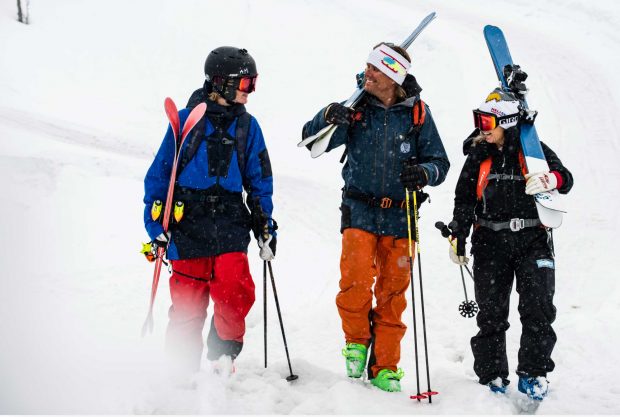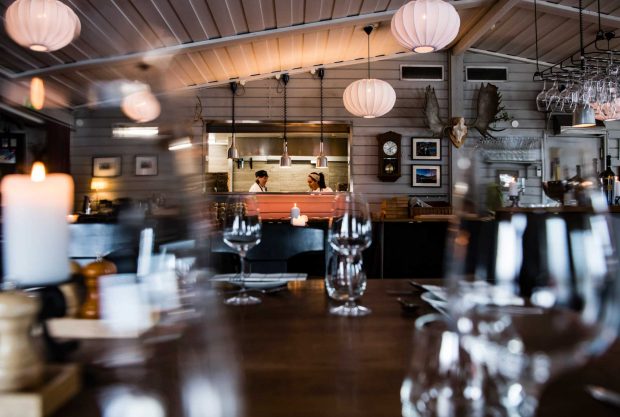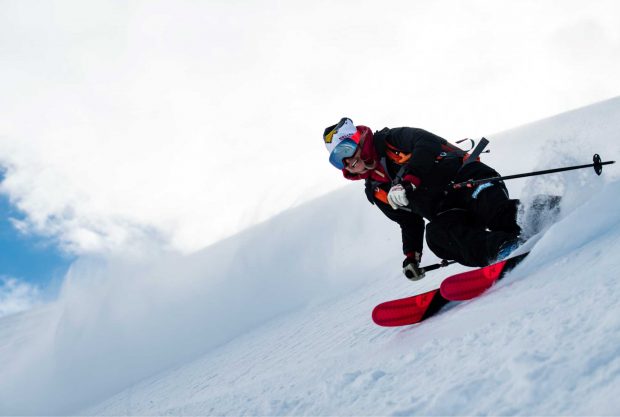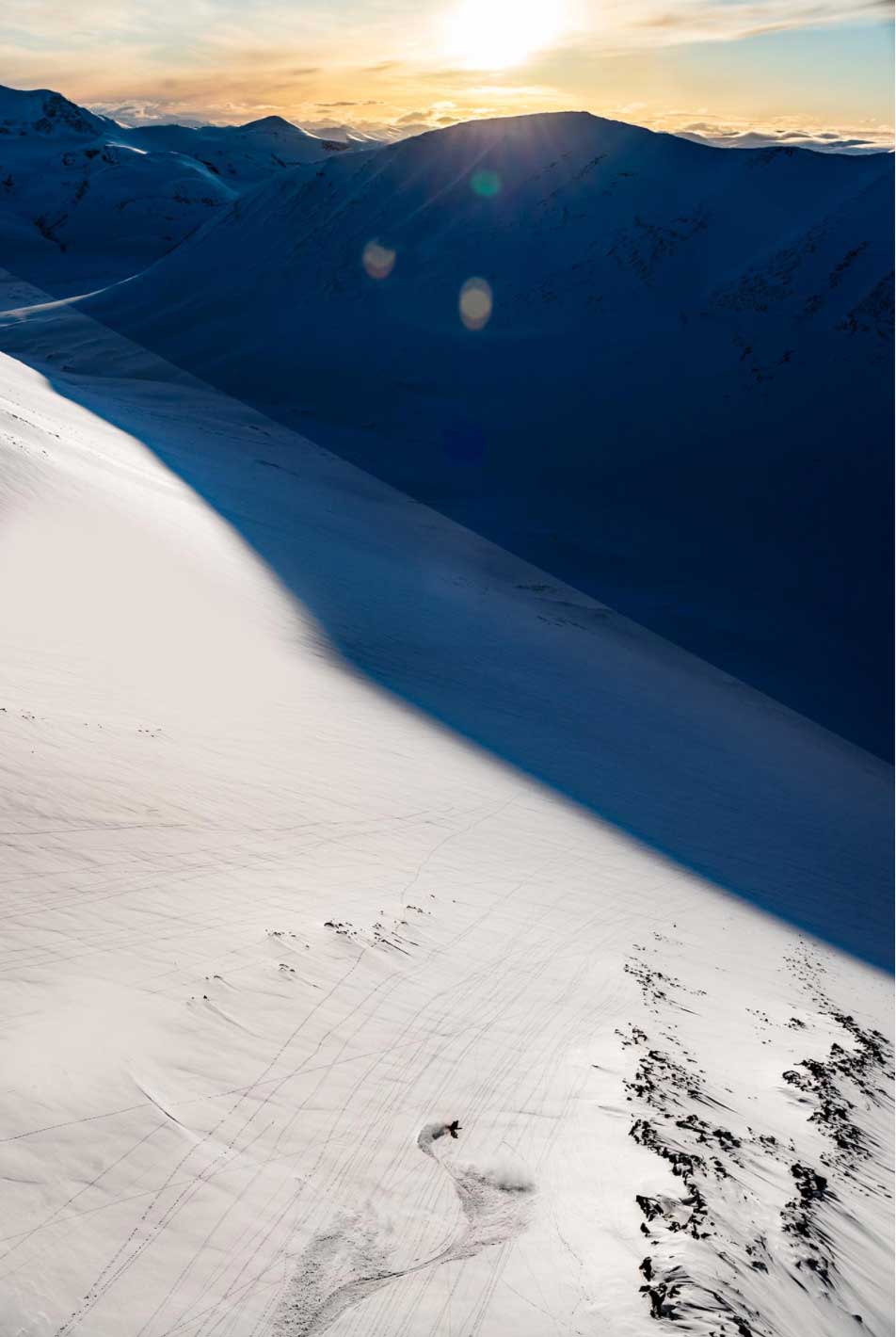Heli Ski Guides Sweden – Abisko Mountain Lodge
Photos by Mattias Fredriksson
It’s late afternoon when we finally lift off, crabbing over the extensive bench of dwarf birch girding Swedish Lapland’s Abisko Alps to Abisko Mountain Lodge. Beating into the wind between two whale-like summits, the pilot contours a ridge on the right to a plateau, where we debark to sunny views in several directions—north to Riksgränsen, the improbably famous ski area in the middle of Arctic nowhere; west to Norway, where jagged peaks ring deep fjords; and south to Kebnekaise, Europe’s last great wildernesses. Between each compass point, pods of geologic Belugas dolphin over the landscape, their alabaster backs barnacled in rock.
Minutes earlier we’d sat in valley-bottom sun outside Abisko Mountain Lodge catching rays in reindeer-skin-draped chairs, so the plateau’s sudden wintery breeze is sharp enough to chase us down the ridge. The run is wind-affected with a definite crunch beneath, so we traverse onto a 2,500-vertical-foot northeast face that promises better. Though it’s a perfect heli-ski run—steep, consistent, uninterrupted—the snow improves only marginally, so I take my time. Conditions be damned, however, two skiers fly past me, egging each other on, arcing huge GS turns through changeable snow at a speed I could never contemplate. Strong and competent, they disappear over a convexity, reappearing minutes later as valley-bottom ants.
One of those skiers is Max Palm, a 16-year-old tearing up the World Junior Freeride circuit. He’d spent most of the day up the road at Riksgränsen qualifying for the resort’s annual Scandinavian Big Mountain Championships which is a part of the Freeride World Tour. The other is Max’s mother Pia, three-time champion of that same event, one she helped ignite in the heady freeride days of the early 1990s. More than mother and son connected by an arcane Arctic freeride heritage, with paterfamilias Stefan often away on global guiding missions they’re unlikely ski buddies as well and watching their pas de deux would warm the heart of any soul skier.

“I’m nervous on days like this,” Pia confesses. Awaiting news of Max’s run and aware of icy conditions on the venue, she’d kept her phone close, flinching whenever it lit up. Now that he’s returned safely and they’re skiing together, she hugs him often, tilting her head to touch his, mind-melding ninja ski skills or maybe just transferring a mother’s love, glad he’s here with her, that he survived and did well, something the demure teen is loath to admit.
“I have no idea how I placed, but I was happy with my run,” Max shrugs. With skiing both a passion and a family business, there’s no point dwelling on an unchangeable past when you’re having fun in the present. At the next drop-off, Max points to an adjacent ridge half a kilometer away where a narrow cornice edges a shallow natural halfpipe. “I can backflip off that,” he tells photographer Mattias Fredriksson, a family friend who’s been shooting him and older sister Robina since they were young. Pia pays no heed to this news—it’s business as usual.
With Mattias set up, Max tracks across the face, drops into the tube and exits in a full inverted layout, landing on the relative flats beyond. Only half joking, I ask Pia how watching something like that is for a mother. “I’m OK with it,” she answers. “I’ve seen worse.”
Flying back to the lodge is a study in the fulsome emptiness of the Arctic, like watching a widescreen film with no edges. Barely discernible among the Pollack-like swaths of dwarf birch, the hamlet of Abisko faces a broad sweep of mountain on the far side of Torneträsk, a massive glacial lake. With only 85 residents and a one-room school, it’s still the biggest village along the lonely road stitching Sweden’s far north to Norway. If you blink, you miss it. I know because I did just that on the way there and had to backtrack several kilometers.
Sweeping into the lodge after a memorable evening ski, we’re soon chasing slow-cooked moose with an excellent Bourgogne Pinot Noir. At a longer table, a boisterous group of fifteen are celebrating their fourteenth trip here and what one describes as “the best day of heliskiing in our entire fourteen years.”

Contrasting the Nordic chic of the airy dining room is a comfortable central lounge of soft sofas, plush chairs, and the typical ski-lodge kitsch—books, photography, art, old skis, moose antlers. A fridge behind the all-purpose front desk brims with microbrews and wine, and you can buy jewelry by local Sami artisans, branded clothing, and the ski items people seem to terminally forget—goggles, gloves, lip balm.
Dick Johansson and wife Mina, who run Abisko Mountain Lodge, have known Stefan for decades, and four years ago had him take over the lodge’s ski touring and heli-ski franchise. The lodge is booked out by northern lights tourism until the heli-ski season begins in late March, running through mid-May—the period locally known as Vårvinter (Spring-Winter). Though Stefan brings a raft of longtime clients to this vernal powfest, more and more first-time clients are being drawn by word of exceptional skiing and the lodge’s relaxed, homey feel.
Overnight, blue skies are traded for a howling storm. Despite the weather, organizers in Riksgränsen do everything they can to make sure competitors get a run in—with more bad weather pending it may be the only chance they get. Trying desperately to ignore her phone, Pia hears through friends that Max has finished, throwing a huge 360 and a backflip, landing both and skiing strongly. “I am so super happy” he texts. Pia glows with pride, and possibly relief. When she receives a TV clip of his run, Mattias and I crowd around her phone to watch. As Max uncorks his 360 the crowd ooohs; when he backflips they go nuts. It stands as the day’s top run.
Later, during dinner, we find out that adding today’s score to his qualifier has put Max in first place overall against the cream of Scandinavian freeskiing. Given tomorrow’s forecast of snow there’s a good chance additional runs will be canceled

and Max will be crowned champ. Pia is ebullient at the prospect, and with Stefan flying in from Iceland tonight, the three will be able to celebrate together—the only lamentable absence is Max’s sister, Robina, who is currently studying communication science at the University of Amsterdam. If Max wins, it will be the closing of an unprecedented circle for Pia and Stefan.
Pia grew up near the ocean outside Stockholm, with a history of ski and mountain exploits on both sides of the family. Her own path started with cross-country skiing, then Alpine racing for a local ski club. There were frequent holidays to the mountains and an annual trip to Austria, driving in a car stacked with three kids.
Spring pilgrimages to Lapland began in the early 1980s before there was a road, when Pia would take the train north with friends. By then a coach at her ski club, she soon started instructing at Riksgränsen, and in 1990 met fellow instructor Stefan Palm. They put in a few springs together, heading to New Zealand to ski when summer hit. As was fashionable for adventurous skiers of the day, they also started telemark skiing, undertaking an expedition to China’s 24,600-foot Muztagh Ata in 1993 with six others including Dick Johansson and photo legend Lars Thulin. Stefan, Pia and Lars summitted, and Dick’s Tua skis from the trip now adorn the wall in Abisko Mountain Lodge.
As befits Sweden’s most famous guide, Stefan’s backstory is also a good one. Originally from the south of Sweden, he got into mountains, skiing and traveling with friends in the 1980s, returning home only long enough to make money for the next adventure. Worried he was wasting his life, his mother met him on the doorstep after yet another trip. “I’ve enrolled you in an outdoor leadership school,” she said, hoping his activities could be directed toward something with a paycheck. She held out a pile of papers on which she’d forged Stefan’s signature. After looking them over—and being impressed with the signature—he decided to give it a try. Two years later he graduated with the kind of experience that allowed him to do jobs like rigging and safety for a live TV event in Riksgränsen. After that particular gig, the fellow overseeing Stefan and a friend was so impressed with their work he’d stated on live TV that they deserved a free trip from the network. Since this same man was about to run Sweden’s first-ever mountain-guide training course, the boys lobbied to trade trip for course, and became two of the country’s first certified guides.
Pia and Stefan also shared a dream of running a ski lodge and were preparing to do just that in Telluride when friend Pelle Lång called. A few years earlier, Lång and a buddy had purchased a small lodge hotel in a lonely French outpost called La Grave known for its off-piste skiing; business was booming and they needed guides. Pia and Stefan moved to La Grave in 1994 to run La Chaumine—a name that would become legendary, as well as synonymous with the infamously rule-free mountain—over the decade they spent there, La Grave was a nexus of the extreme-ski universe, and La Chaumine its de facto center.
Stefan and Pia ultimately moved to the larger ski town of Serre Chevalier to purchase a house and raise a family. Already a strong, fast skier as befit her heritage, Robina—who the family calls “Robi”—raced with the Serre Chevalier ski club for a few years, a good technical foundation for the freeskiing style she and Max would eventually adopt. As Stefan travelled more as a private guide and the kids grew, need arose for more schools, more culture, and a more convenient airport. After ten years in Serre Chevalier the family uprooted to the little village of Servoz, an hour from Geneva just below Chamonix. From there, Stefan guides around the globe– Japan, India, Iceland, Norway and the Chilean Andes, where he’s known as Sabuezo Sueco—“the Swedish bloodhound”—for his unerring knack of always finding the best snow. But the most important trip he makes each year is back to Swedish Lapland, where it all started.
Stefan and Pia introduced heli-skiing to northern Sweden, initially operating through the Riksgränsen ski school. Now they conduct private heli-skiing under their company Heliski Guides Sweden, with Stefan as lead guide, Pia as coordinator, and Robina lending expertise to social media and other marketing efforts. In 2015, they decided to base out of Dick’s Abisko Mountain Lodge, getting the old Muztagh Ata crew back together, so to speak. With its jaw-dropping scenery, 20-person capacity, and two helicopters at the door, it’s one of the most exclusive and unique heli-ski operations in the world, benefitting from oversight by the area’s de facto pioneer. “Stefan has an amazing ability to see lines and find the best snow,” says Dick. “His routes and knowledge of these mountains are totally unique.”

After skiing with Stefan, it’s hard to deny the snow-sniffing skill of Sabuezo Sueco. But it’s also hard to deny the family’s long-time connection to this sweeping land, to who they are, what they do, and their love for its fragile qualities. “You have to feel something from this light,” Stefan once told me after we’d scrambled to the top of a peak near Riksgränsen around eight in the evening, only to be washed in copper as we descended. It was then I understood how you could love something too big to comprehend.
As expected, further competition is cancelled the next day and Max is declared winner of the 2019 Scandinavian Big Mountain Championships. I drop everything to join Stefan and Pia as they drive the hour to Riksgränsen to congratulate him. Pia literally shakes with excitement en route, aided by a cappuccino downed before we left. Stefan’s feelings are revealed more subtly, in a story of a bad early season in Chamonix when it was so thin, he didn’t bother skiing. Max, meanwhile, went every day, taking the bus, skiing bell-to-bell on his own because his friends weren’t interested. “He didn’t want to play video games while there was any kind of skiing available,” says Stefan, proud less of Max’s preternatural abilities than the passion he displays.
When we arrive, it’s to the sight of Max being interviewed on TV. Presumably, the last thing a 16-year-old wants to see while he’s on camera is his parents strolling up, but he manages to keep it together. Once the interview concludes, however, he’s fair game for hugs and backslaps—including from the event’s venerable founder, Robert Gustafsson, with whom Pia worked to found the event twenty-seven years earlier. Not only is Max the youngest winner ever, remarks Robert, but the first with a parent who has also won, a generational watershed.
My last day with the family Palm is golden. With new snowfall blanketing the peaks and clearing skies, we fly off to explore one of Stefan’s “secret” stashes, and find faces and gullies filled with powder and ski line after un-tracked line on a variety of exposures. Max even throws a massive, celebratory back flip off a cornice into a steep bowl, almost wiping out before pulling it together at the last second as only a rubber-bodied teen can.
We lunch in the sun on rolled-out pads, sharing a massive thermos of thick, potato-leek soup, followed by coffee and homemade kanelbulle, a traditional Swedish cinnamon bun. Mattias needs a dramatic background for some final photos, and Stefan suggests a zone to the southwest, where the snow proves to be three times as deep as anything we’ve skied, rippling across steep, shadowed slopes in unconsolidated waves. It’s not just the best powder of the trip, but the best I’ve skied in a dozen trips to Sweden.
Related Posts
Nothing found.

